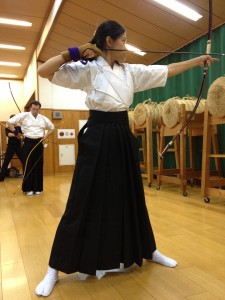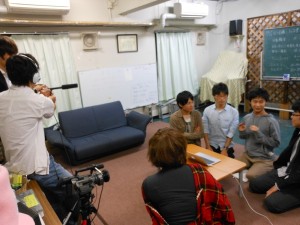This semester I’ve been going to Kyudo, or Japanese archery practice twice a week at the Budou Center. I was fortunate that on my first visit I met Kawaguchi Sensei, a petite and energetic 80-year-old woman. She was wonderful despite the language barrier and we’ve all come to really love her. Other than we few gaijins at the dojo, everyone else, mostly Japanese, has been practicing there for at least a while. I was surprised at how tirelessly Sensei devoted her time to teaching us, some of us knew zero Japanese. Other members of the dojo do not normally come up and talk to us, but if I ask for help or questions in general they have been very patient and kind. The dojo is also very international and I met so many interesting people there. Three professional artists (pianist, photographer, multimedia artist) from German started practicing with us around the same time and we’ve cultivated friendship and been going to their performances and such.
For me at first, as someone who has practiced Western archery before, I was surprised to find how ritualized Kyudo is as a martial art. I wasn’t very sure if I could stand the endless aisatsu, or greetings, or the left-foot-first-right-foot-second sort of ritualized steps, but slowly I’ve gotten used to it and begun to appreciate the beauty in these traditions. Life in Kyoto has been quite busy and overwhelming but I found my times at Kyduo, twice a week, to be the most calming. It’s only at the dojo that I can clear my head of everything and just focus on one thing, the arrow.
My second activity is the Gakusei Terebi circle, or the Doshisha Student TV circle. GakuTere makes TV specials, documentaries, commercials aimed at Doshisha students. This sounds very intense but the atmosphere is very relaxed. My circle-mates have been very friendly especially considering how little I understand and speak Japanese. Since I was the only person joining the circle this semester (because most people joined in April), I was invited to many hot pot parties or events of that nature, which made me feel very welcomed.
The biggest difficulty with Gakusei Terebi, however, is definitely the language barrier. Unlike Kyudo, where you don’t need to communicate with others too much most of the time, communication is everything in Gakusei Terebi. People speak very fast there, mixed with kansai-ben, and, in typical Japanese fashion, never ends a sentence and just goes on with 〜て、〜て、〜けど…, so it’s easy to lose track of what one’s saying. This is not to say that I did not enjoy the experience at Gakusei Terebi. I’ve been to both bangumi-making sessions and their parties, and even though I am still in the kengaku stage and can only say that I understood about 40% of what they say most of the time, I have enjoyed and value my experience at GakuTere very much.


Wow that’s really amazing that you were capable of doing two CIPs this semester! It seems like you have been pretty successful in immersing yourself in Japanese culture. What did you feel were the main differences between the more traditional activity of Kyudo and the Doshisha Student TV Circle? Which do you think is most effective in terms of meeting more Japanese people and improving language skills?
Hi Astrid! My answer to your first question basically answers the second as well. I think the most important difference between Kyudo and Gakusei Terebi is that Kyudo is more or less a private, individual activity during which your interactions are mostly with Sensei and then it’s just yourself internalizing what you have been taught. I especially do not like to talk to people in general when I’m practicing Kyudo. Gakusei Terebi, on the other hand, is all about communication and team work regardless of it’s making a commercial or hosting a nabe-pa. So I’d say that joining student circles is the best way to meet your peers and improve your language skills so long as you are bold. Private lessons like Kyudo are what they are–more or less individual lessons to improve or develop something inside YOU.
Both of your CIPs sound like They turned out really well. I was wondering about the specifics of Gakusei Terebi though. You said that everything was about language and there was a lot you didn’t understand so how involved were you in the actual activities. We’re you kind of a bystander most of the time or do you get to do more than that?
Hi Alex, thanks for commenting. I came in midway during the school year so I probably missed a lot of their basic training sessions so I did some 見学 (shadowing) when they were making or editing videos. They usually have a general agenda for each meeting that determines what people could choose to do during that session and I’d say that they tried their best to get me involved and I did feel involved. The language and bystander problem came in when they are just talking, reporting, and planning during the beginning of each meeting because I can’t follow most of what they were saying and therefore I can’t contribute to the conversations as I would if I were in an American club.